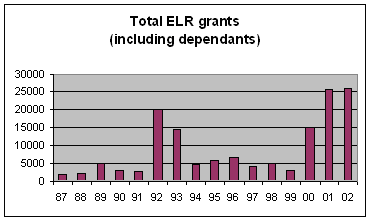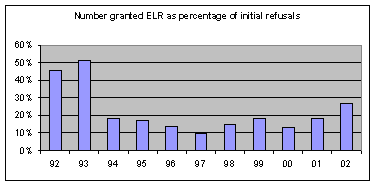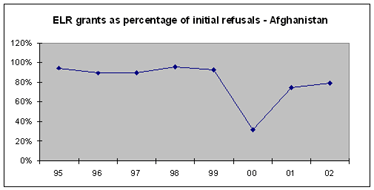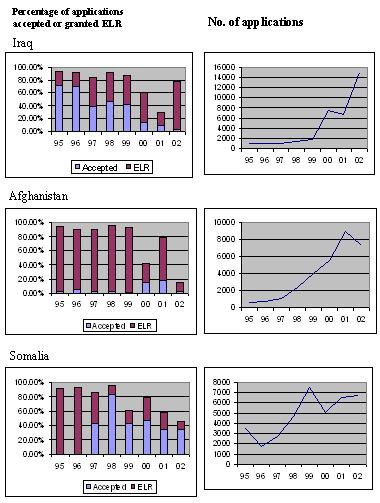A Review of Exceptional Leave to Remain and Humanitarian Protection
Updated 8 April, 2003
Summary
1.On 1 April 2003 the Minister for Citizenship and Immigration (Beverley Hughes) outlined the results of the review of the use and scope of exceptional leave "to focus on those who really need special humanitarian protection but do not qualify as refugee"[1] . The review was established by the Home Secretary in October 2002 and at that time he also announced the ending of the routine granting of exceptional leave on a country basis.
2.In making the statement to the Commons the Minister said: "In the past, exceptional leave has been used far too widely - it was only ever intended to be granted to those able to demonstrate compelling compassionate or humanitarian reasons for staying in the United Kingdom. Instead the widespread use of exceptional leave has acted as a pull factor, encouraging economic migrants to apply for asylum in the United Kingdom in the belief that they will be given exceptional leave when their claim is rejected.[2]"
3.From 1 April 2003 exceptional leave to remain has been replaced with a new Humanitarian Protection system. The Home Secretary will also retain the discretion to grant limited leave in "defined and tightly focused" circumstances. However, no details have been given of what these circumstances are and the way the system is implemented in detail will determine whether the numbers granted leave will actually reduce or whether this is a change in name only.
4.Exceptional leave to remain (ELR) in the United Kingdom was given at the discretion of the Home Secretary when an asylum seeker's asylum claim had been refused. The number of grants of ELR had been rising rapidly from levels of 3,000 to 6,000 in the period 1994 to 1999 up to 26,000 in 2002 [3].
5.The percentage of asylum seekers refused asylum but subsequently granted ELR has also been on an upward trend in recent years and was about 25% in 2002.
Humanitarian Protection
6.From 1 April 2003 ELR is replaced with 'Humanitarian Protection' which "will be granted to those who, though not refugees, would, if removed, face in the country of return a serious risk to life or person arising from the death penalty, unlawful killing or torture, inhuman or degrading treatment or punishment"[4] .
7.Under the new system those who qualify for Humanitarian Protection will be granted leave for three years, at which point a person with a continuing need for protection will be eligible to apply for settlement in the United Kingdom. A person with no continuing need will not get any further leave.
8.The Secretary of State will also retain the discretion to grant limited leave to those who do not qualify for Humanitarian Protection or leave under the Immigration rules. The circumstances in which Discretionary Leave will be granted will be defined and tightly focused. This leave will normally be granted for two periods of three years, but there is scope to grant shorter periods depending on the individual circumstances. Again, it will not be renewed unless a person continues to qualify for such leave.[5]"
9.The new categories of Humanitarian Protection and Discretionary Leave closely resemble Exceptional Leave. The main reason for granting ELR in the past has been the difficulty of returning people to their home countries because of a general breakdown of law and order, civil war etc. It remains to be seen whether these people will be granted Humanitarian Protection in future and, if not, whether any effective action will be taken to remove them from the UK. Nor do we know what circumstances will give rise to 'Discretionary Leave'.
Exceptional Leave
10.Section 3(1)(b) of the 1971 Immigration Act gives the Home Secretary the right to grant exceptional leave to remain (ELR) in the United Kingdom for a purpose not specifically provided for in the Immigration rules.
11.Exceptional leave could be granted for up to 4 years and, since July 1998, a person who has completed four years on exceptional leave may apply for Indefinite Leave to Remain. Prior to July 1998 the qualifying period before an application for indefinite leave could be made was 7 years.
12.A person who has been granted ELR has the same employment rights and access to benefits and other state support as a refugee. In practice the main differences between persons granted ELR and those granted asylum are that they:
| 1. | Do not have immediate rights to settlement. | |
| 2. | Do not have access to a refugee travel document. | |
| 3. | Will usually have to wait 4 years before they gain family reunion rights. |
13.Exceptional leave was granted for a wide number of reasons. The main categories were:
| 1. | Where it has been impossible to return people to their home countries. | |
| 2. | Where the individual had failed to advance a successful asylum claim but was able to advance a compelling compassionate or humanitarian reason why they should not be removed. | |
| 3. | Where removal of the individual would have breached the United Kingdom's obligations under the Convention for the protection of Human Rights and Fundamental Freedoms (commonly referred to as the European Convention on Human Rights or "ECHR"). | |
| 4. | Where the individual was an Unaccompanied Asylum Seeking Child and the U.K. was unable to make adequate reception arrangements for the child if returned. | |
| 5. | Where the applicant had waited 7 years for an initial decision to be reached on their asylum application and the delay had not been the fault of the applicant. |
14.Asylum Group caseworkers considered whether ELR should be granted when they were giving consideration to asylum claims.
15.There appears to have been no detailed guidance on what constituted "compelling compassionate or humanitarian reason why they should not be removed". Caseworkers made a judgement based on the individual's particular circumstances and on the detailed country assessments provide by the Immigration and Nationality Directorate. In practice, asylum seekers from only 3 countries, Liberia, Libya and Somalia, were routinely given ELR on a country basis. In 2001 they accounted for 11% of the total number of ELR grants.
16.The ECHR defines a number of human rights which signatory States must guarantee at all times.). The ECHR does not impose a general obligation on States not to remove someone even when that removal may lead to a violation of their Convention rights in another country. However, it is a breach of the ECHR to remove someone where it is shown that Article 3 rights (no one shall be subjected to torture or to inhuman or degrading treatment or punishment) will be breached. This could be a direct, or an indirect, breach. Indirect breaches of Article 3 occur when other fundamental rights are breached to such an extent as to constitute torture, inhuman or degrading treatment or punishment. However, treatment which does not amount to persecution under the U.N. Convention on Refugees would rarely be sufficiently severe to breach Article 3 of the ECHR.
17.Article 3 of the ECHR may also be breached on medical grounds where there is a complete absence of treatment, facilities or social support in the asylum seeker's home country which may result in a painful death and cause acute physical or mental suffering. In practice this could mean, for instance, that many refugees who are suffering from HIV/Aids could not be returned to their country of origin if this is a developing country.
18.Article 2 and Protocol 6 of the ECHR, which give a "right to life" and which abolish the death penalty respectively, would prevent refugees being returned to countries which impose the death penalty for the crime which the refugee has committed. Sometimes this is circumvented by the country concerned agreeing to forego capital punishment in the specific instance.
19. ELR was also granted where Article 8 (respect for private and family life) was breached if an asylum seeker was joining a member of a family long-established in the U.K. and it was unreasonable to expect the family to follow the asylum seeker back to his country of origin.
20. The number of grants of ELR was consistently around or below 5,000 per annum in the 1990's (with the exception of 1992 and 1993) but has increased rapidly from year 2000 with the increase in asylum claims and the processing of the backlog of claims and reached nearly 26,000 people including dependants in 2002 [6]. This is demonstrated by the following graph:

21. The percentage of initial decisions resulting in an ELR grant has varied widely over the last 16 years but it is currently running at its highest rate since 1993. 27% (or more than 1 in 4) of people whose asylum claims have been refused were granted ELR in 2002. The figures for previous years are shown in the following graph.

22. The Home Office put this variation down to the particular circumstances and sources of those seeking asylum in the U.K.. Although this may well be a significant factor, when decisions are analysed for individual countries there would seem to be variations which cannot be readily explained by the circumstances within that country. For example, ELR grants for Afghanistan show this pattern [7]:

23. In the period from January 1992 to June 2002 inclusive, one country Somalia accounted for over 22% of grants of ELR. Four countries: Somalia, Afghanistan, Iraq and Sri Lanka account for 61% of ELR grants in this period.
24. Once granted ELR the likelihood is that an applicant will be given indefinite leave at the end of the four year qualifying period. The system of reviewing cases after an applicant has spent a period of time on exceptional leave has fallen into disuse. Further exceptional leave or indefinite leave may be refused where the country of origin is now considered safe but, even in these cases, the Home Office will take into account whether the person should be allowed to remain because of the ties they have developed in the U.K.
25. Granting ELR usually goes beyond the United Kingdom's international obligations. It results from understandable humanitarian concerns for people who originate from countries which are generally torn by civil war and poverty, compounded by poor governance. However, giving people a right to remain in the United Kingdom for these reasons does not help to resolve the problems. On the contrary, increasing the likelihood of refugees being given leave to stay in the U.K., even though they are not in need of asylum, is only likely to encourage trafficking in people and to make the situation worse for genuine asylum claimants. High levels of ELR grants combined with an inability to remove those who have been refused asylum and ELR have made the U.K. a very attractive destination.
26. The routine granting of ELR in the latter half of the 1990's to asylum applicants from some major source countries meant that the vast majority were granted either asylum or ELR at their first application. This was one of the factors that led to a very sharp increase in the number of asylum applications. The following graphs demonstrate this very clearly.

Outlook.
27. Whether the abolition of ELR will make any difference will depend on how the new "Humanitarian Protection" is administered and on the scale of "Discretionary" grants by the Home Secretary. Neither will have any practical effect unless the level of removals is substantially increased from the present 13,000 a year. The Government have now abandoned any specific target - their current aim being only to increase the proportion of those refused who are later removed.
Footnotes
| [1] | Hansard - House of Commons - 1 April 2003: Column 54SW |
| [2] | Hansard - House of Commons - 1 April 2003: Column 54SW |
| [3] | Source Home Office Asylum Statistics - with allowance of 30% for dependants |
| [4] | Hansard - House of Commons - 1 April 2003: Column 54SW |
| [5] | Hansard - House of Commons - 1 April 2003: Column 54SW |
| [6] | Source Home Office: Asylum Statistics various years - principal applicants plus 30% for dependants |
| [7] | Source Asylum Statistics - based on first half of 2002 only |
